
|   |

|   |
Nartanam Conclave 2018 on Music in Dance: Part 2 - Lalitha Venkat e-mail: lalvenkat@yahoo.com Photos: Pranay Rupani October 20, 2018 Nartanam Conclave 2018 on Music in Dance: Part 1 The Sahrdaya Trust, publisher of the Nartanam quarterly, headed by scholar and chief editor Madhavi Puranam, hosted the second edition of the 4 day Nartanam Conclave on 'Music for Dance' from October 5 - 8, 2018 at the pleasant MCR HRD Institute of Telangana campus in Hyderabad. The mornings were devoted to lec-dems and paper presentations followed by one dance performance in the evening. 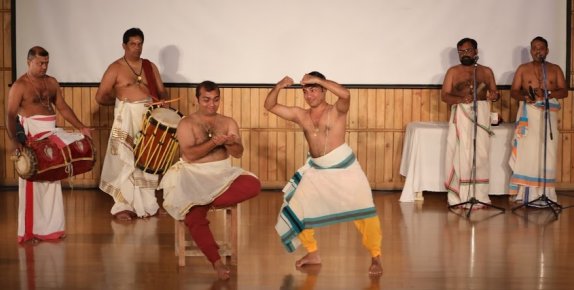 Kathakali demo Kathakali is a medley of music, drums and dance. Day three had a good start with a well structured lecture on 'Kathakali music: Evolution and nuances' by cultural writer and author K.K. Gopalakrishnan. Introducing the session, chair Jayachandran, a scholar from Kalakshetra, said 'katha' (story) is set through 'kali' (play). It is an essential yearning of humanity. The characters come from a different zone and cannot talk in a regular tone. Essentially, it is about "Can I make a private conversation public?" Music is the essential stance through which this is possible. 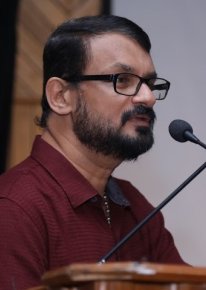 KK Gopalakrishnan Gopalakrishnan's power point presentation helped the rasikas to easily understand the finer points about Kathakali music and the demonstration by Kalamandalam Adityan and Kalamandalam Vipin with musicians of Kalamandalam Gopi asan's troupe enlivened the proceedings. Gopalakrishnan clarified at the beginning that Kathakali is not mere dance but dance theater with several dramatic episodes, hence the music is for dance theater. Kathakali music is a blend of vocal rendering with the two percussions, maddalam and chenda (introduced later by Vettath Raja in C1600 when he was reforming Ramanattam). The temple music tradition known as Sopana Sangeetam is well suited for Kathakali with its rich organic and ethnic traits and was the mainstream among the indigenous music traditions of Kerala. Exposure to Carnatic music revitalized it. The applied music for Kathakali is abhinaya sangeetam, music for acting based on Sopana Sangeetam. Music here is to support a bhava and a particular raga can be used to portray different emotions - a love scene dominated with eroticism or a scene of separation or even a war scene. Paati raga is associated with the introductory shringara pada of hero roles in kathi attire, such as Duryodhana, Keechaka, Ravana, Narakasura etc. Raga Madhyamavati got deeply associated with the role of Hanuman. Performance to a vandana sloka and interpreting ragam Shankarabharanam in 3 different ways was enlightening. Krishnanattam and its predecessor Ashtapadiattam (now extinct) confirm the existence of a strong musical tradition with ethnic ragas and talas. Kathakali uses four important basic talas - chembata, chemba, adanta and panchari. Lakshmi, marmam, kumbham, kundanachi, etc., are among the unique Kerala talas. Kottayam Thampuran (1645-1716) is considered the principal creator of the Kathakali repertoire. Two vocalists and two drummers were core musicians from the premiere of the first Kathakali play. "It was Nemmara Madhava Menon (1874-1913) who probably first adapted the flavours and elements of Carnatic music to better his presentations for Kathakali. Venkitakrishna Bhagavatar (1881-1957), the first maestro of the Kerala Kalamandalam, introduced it there to cleanse students' throats for proper raga bhava. Substantial restructuring of Kathakali rendering during the 20th century happened through Venkitakrishna Bhagavathar and his prime disciple Kalamandalam Neelakantan Nambeeshan (1920-1985)," said Gopalakrishnan. For the pitch, the harmonium was replaced by the manual shruti box; then the verses were sung for the shruti of the bronze gong and the humming of the supporting singer. Now the electronic shruti box is popular. Fascinatingly, all the accompanying instruments - maddalam, chenda, gong and cymbal - produce varying shrutis and often both the singers too perform in different shruti, "creating a shruti out of the amalgamation of incoherent shrutis!" Earlier the singing was drowned in the sound of the percussion and singing in open ground in foggy weather did not help the throat. The advent of microphone revolutionized the vocal rendering. With regard to acting, padaartha abhinaya (literal interpretation) is followed in Kathakali and thus the acting methodology is known as cholliyattam. The raga alapana is dovetailed in Kathakali not to establish the raga by itself or its various aspects, but to create an ambience for the mood of the dramatic situation. The literature of Kathakali known as attakkatha is divided into slokam, padam and dandakam. Gopalakrishnan gave a brief background of the personalities involved in the development of Kathakali music at various stages and concluded with how people today have started to listen to Kathakali music thanks to a bunch of young and extraordinarily brilliant singers like Shankaran Embranthiri, Hyderali and Venmani Haridas. The talk was supported by vibrant demos of an excerpt from Kalyanasougandhikam, a dandakam from Keechaka Vadham, an ashtakalasam from Subadra Haranam with Krishna and Balarama. The musicians were Kalamandalam Babu Namboodiri and Kalamandalam Vinod on vocals, Kalamandalam Krishnadas on chenda and Kalamandalam Rajnarayanan on maddalam. It was a gripping presentation. 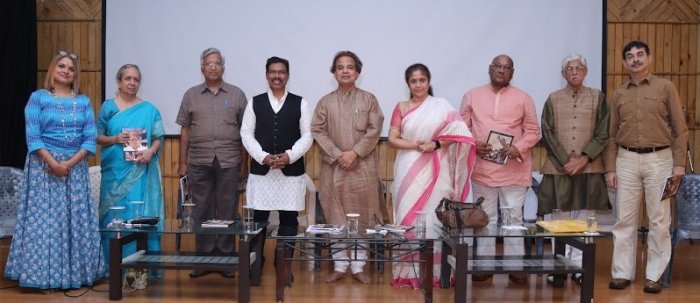 Madhavi Puranam, Vijaya Ramam, Dr. Suresh Goel, Mamidi Harikrishna, Jayant Kastuar, Dr.Ananda Shankar Jayant, C. Anjaneya Reddy, Dr. Kiran Seth, Jayesh Ranjan The next session was a panel discussion on 'Arts Management and Policy' in an attempt to bridge the pillars between the government, the artist, the scholar and the corporate. The eminent panellists were from various fields. The chair Jayant Kastuar (Former Secretary, SNA) initiated the discussion. He said our performing arts in an outstanding range with millions of performers, varied genres of music and dance, Vedic chants, folk forms etc have a great impact on our culture. "From 1947 onwards, new mass media of radio and films represent largest performing arts today. Traditional, folk and tribal arts are indigenous forms to sustain the world view of each community. To sustain means to create and then perform. Dance is an ephemeral art and the best way to preserve it is to create more performance opportunities and performance spaces. Artist alone does not create art. Only with the presence of rasikas is rasa created. Training, research and production comes next with associates like music composers to play their part," elaborated Kastuar. Based on their status, roles, perspectives and experience, the panellists were requested to give suggestions on what can be done to enhance the role of performing arts, who can do what, what goals could be achieved, what is expected of the artist and what the artist expects from society. Dr.Suresh Goel (Former Director General, ICCR) spoke on the perspective of one experienced as a cultural administrator and manager. He said, "Cultural policy is a misnomer. Fragmentation and polarization makes it a messy issue. At the time of Independence, India had to establish a cultural identity. Cultural management on national level suggests government having an authority on what to promote and how to promote, but 99% do not know what to promote. One first needs to find out if the government has the capacity to manage arts and I think they do not! They must first develop an idea of arts for the society. People should be able to understand that without the arts, there is no soul for the society. The govt can do that but it needs resources which the govt does not have. Also, govt patronage gets into political tones. Independent institutions can promote art at a national and international level. Corporates need incentives on how to develop and promote the arts, like painting, photography etc. Every corporate sector looks for branding. They could do that through the arts." He concluded that our cultural icons who have gone overseas popularized our arts including Bollywood. C. Anjaneya Reddy (Retd. IPS) declared that our rural art forms are dying by the dozens all over the country and the govt has no idea how to revive dying art forms like Harikatha, Pandavani to name a few. Nothing is being done to revive and revitalize them. That's where the govt role comes in. Young artistes don't know how to establish themselves. He suggested that corporates could come in and help adapt these art forms to the modern stage. In Karnataka, Yakshagana is thriving whereas the older Telugu Yakshagana is dead! He warned that at this rate, rural and desi theatres and forms require attention or they risk dying out. Dr. Kiran Seth (Founder, SPIC MACAY) said the crux of our art forms focusses to something abstract, subtle, inspiring and mystical, be it a music genre or a folk painting genre. Forms which have great entertainment value have the capacity to take people along. The refined arts were supported by the rajahs. The whole scenario has changed now. "What should have been means to an end has become the end itself. Some artistes dumb down the dance or music to reach the audience. We have to nurture great masters like Kelubabu, Balasaraswati, Sanjukta Panigrahi… The govt should set aside a certain amount to support these things. I go to a playschool every morning before I go to IIT because art appreciation starts from childhood. Whatever has to come to intangible domain has come through tangibilization," concluded Dr.Seth. Jayesh Ranjan (Principal Secretary, I & C and IT, Telangana) professed to technically belong to govt circle but makes it a point to attend cultural events. He opted to speak for the audience, on 3 realities. One is opportunity to engage the audience, competes with multiple other opportunities. One has to manage time and see what value we get for money. "More than 65% of our population is below 30. So we need to create value proposition - tangible and intangible." Second is access and quality. Do we have enough performace spaces and can audience reach there? Intimate cultural spaces are needed and they should be evenly spread. Audience should have awareness of other forms of art too. Third is choice of art forms. The wide range includes classical arts, modern arts, folk forms etc. Some patrons like nawabs chose only particular art forms. That's where corporates could come in and choose a form that appeals to the sponsor. Vijaya Ramam (Management consultant, L.V.Prasad Eye Institute) and her sisters were dancers. She said, "When we started in the 1950s, my family promoted us despite ridicule in society, but we made a name and fame and money too. Dance as a profession is not very encouraging as young dancers have a hard time sustaining themselves. Audience is important too. How do you sensitize the audience to attend programs? It is needed to preserve our arts. Our artistes abroad who are propagating our culture feel left out. They get no recognition in our country. How can the govt encourage them to continue pursuing our art forms? Many of them senior citizens now are in tough times. What is the govt doing to help them? Padma awards get no advantage. We at L.V.Prasad Eye Institute have recently got into promoting performing arts because we want to sensitize our staff to the arts." Dr.Ananda Shankar Jayant (bureaucrat, dancer, Director, Shankarananda Kalakshetra) decided 'not to whine.' According to her, first and foremost as a nation, we need to bring in arts in education. "Somewhere our system is flawed. You are either an engineer or a dancer. You can't be both. It would be wonderful to teach Bharatanatyam with Maths, Kathak with science. Infrastructure is a govt and corporate requirement, but it should be affordable. Shilpa Kala Vedika is lovely but costs 1 ˝ lakhs! Without extraordinary dispensible inheritance, these expenses are out of reach. Students who leave an institution - like Kalakshetra - should be employable. For dance, outflow is higher than inflow. Oportunity is a word I don't like. You don't say it to a doctor or engineer. Why not use a word like 'ownership'? After retiring, one can come back to the arts, but for that, one must find a reason that the arts is good. How can we empower the arts through social media? Embrace the digital. CSR meaning Cultural Social Responsibilty is important. The only thing we leave behind when we leave this world is our arts and culture." Mamidi Harikrishna (Director, Language and Culture, Telangana) waxed eloquent on the great things happening in Telangana. He said the Govt of Telangana has devised a 4 part policy for culture based on the 4 R strategy - restructuring, redefining, rejuvenation and re-exploration. The process is going on with promotion and popularization. "Art should live for ever. When artist lives, art lives. For that he needs livelihood. Just chance to perform is not enough. It has to be supported with cash. Artists need audience, appreciation. We even mobilise people to fill the auditorium. We use the AAO approach - Artist friendly approach, Audience friendly approach, Organizer. Without organizing nothing can happen and we are doing that systematically. Culture is a rainbow of folk arts, tribal arts, performing art forms, theatre, literature etc. We are also documenting the art forms. We have an action plan to engage the artistes through the year." Full of enthusiasm, Harikrishna said they were trying their level best to improve themselves and extend their hands for the benefit of the arts. There is a plan to have a folklore academy, just like SNA and Sahitya Kala Akademi. The final speaker of the session was Madhavi Puranam (curator of the conclave) who smilingly spoke of the "rock stars in music and dance who had brought their own fan following to the conclave!" She advocated doing more as parents to inclucate love of the arts in children. Seeing art is the only way to cultivate the arts. What are deliverables? None other than helping propagate an art form. "As a spectator, I have seen mostly mediocrity. Are the artistes able to offer quality? There needs to be some guidelines. Artistes, people, govt, corporates could arive at solutions. Unfortunately, people at the helm of affairs have less understanding of the arts." Jayant Kastuar brought the panel to conclusion by naming people like late Keshav Kothari who had given a lifetime for the arts at the expense of sacrificing their own aspirations. The enthusisatic audience came in with their own solutions summing up that cultural spaces and rehearsal spaces are the need of the hour. Artistes can themselves take the initiative and tackle problems, participate and take ownership! 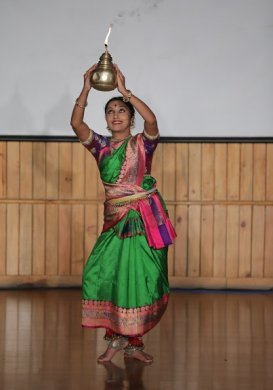 Andhra Natyam demo Post lunch was a presentation on 'Music for Perini' by Kalakrishna. The chair, Dr. Alekhya Punjala (First female Registrar, Potti Sriramulu Telugu University, Hyderabad), expressed her pranams to Guru Nataraja Ramakrishna, "the architect of this beautiful temple ritual form with its unique techniques of learning and presentation." She said Guru Kalakrishna has added elements of his own imagination and these nuances add to the appeal of Perini. Perini as tandava element and Andhra Natyam as lasya element are being taught in universities now. She praised Kalakrishna for "trying to keep the flock together and leaving no stone unturned in achieving his objective to make Perini well known." 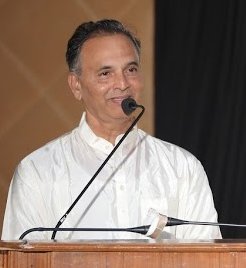
Kalakrishna
Perini is a part of Andhra Natyam. When Andhra Natyam was introduced in Telugu University, C Srinivasulu urged Nataraja Ramakrishna to add Perini to the training. How was Perini music adapted from Andhra Natyam music? In Perini, his guru mostly concentrated on rhythm and omkara, said Kalakrishna. After a demo of Kumbaharathy, Kalakrishna said after singing of churnika, the priest would give a flower to the rajanartaki. Nataraja Ramakrishna adapted from the temple tradition to the stage tradition. There was a vigorous demo of vinayaka tala (which somewhat resembles adi tala) and shows only raudra and veera rasa. From 1982 - 1995, there were lots of changes in the temple rituals. Adyatmaramayana kirtanas were developed by Saride Manikyamma who used to sit and perform them. Some jathis were added to the original temple asthana to suit the stage, said Kalakrishna.  Perini demo by Perini Kumar There are specifications for placement of the musicians and dancer on stage. Tham is important like in Bharatanatyam and Kuchipudi also. There was demo of Pallavi adapted to Perini form, reconstructed by Nataraja Ramakrishna who added some jathis to it. Perini Kumar's vigorous exposition of the Perini form was proof enough that one needs to be highly physically fit for the strenuous footwork! "Nataraja Ramakrishna did not say Perini belonged to Telangana. Perini was popular in Gujarat, Bengal and Karnataka. But it was reconstructed only in the Telangana area. Till his death, Nataraja Ramakrishna struggled for both forms," stated Kalakrishna with heartfelt reverence. The reconstructed 5 elements of nature in kaivaram style was demonstrated. The dancer wears 155 bells in the left leg ghunguroos and 125 in the right leg as there is more stress on the left leg. Nataraja Ramakrishna did not touch the parijata prabanda in Perini, was suitably enacted by Kalakrishna himself. Though one is left a little confused with the details of revival of both the dance forms, its structure and music, ultimately it is an admirable fact that Nataraja Ramakrishna's hard work in reconstructing Perini brought it to the stage to be handed over to the future generation. Alekhya suitably summed up the contribution of both the gurus. "Nataraja Ramakrishna put his everything into this - music, tech, presentation has been put together with a lot of thought. What he had in mind has taken form in Kalakrishna's presentation and fructified. Kalakrishna has retained it and is trying to take it forward," she said to thunderous applause. The last day of the conclave was devoted to the music of Bharatanatyam, Sattriya, and Manipuri. In her presentation 'Music for Bharatanatyam,' Dr. Ananda Shankar Jayant traced the features and music for the items in the margam. She said, "Music for Bharatanatyam has traversed a lot since the days of the Tanjore Quartet. What we see is a beautiful progression of how a performance can be conceived and how it is received by the audience." She commenced with a little demo on Alarippu by her disciples. "This first item is brief, non textual, non rhythmic, with a little nritta and allows the body to open up. In jathiswaram, you extend the nritta a little further set to simple swara patterns, with simple adavus and talams; it is like a warming up. Shadbam in its very musicality uses simple talams and straightforward ragams. Abhinaya gets into the presentation for the first time. This becomes a bridge between the pure nritta piece jathiswaram and the next piece varnam. The expressions are padartha abhinaya and a little bit of sanchari is used. Varnam combines nritta, nritya and natya. It can be pada varnam or daru varnam. Stretching to almost an hour, it is a test for the musician as well as dancer. With kirtanam, you start winding down. The swara or tala depends on the verses used. Mostly shringara based, the winding down continues in padam. The fun element comes in the javali. Light ragas, madhya kala laya, simple poetry and simple situations are its features. The final thillana is footwork and music oriented, concluding with a slokam. The bhakti srinagara leaves you in a shantam mood. The margam has created a nice pathway," described Ananda. The items were demonstrated suitably by Ananda and her well trained disciples. 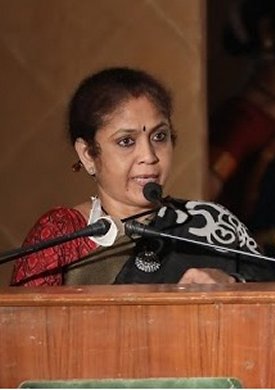 Ananda Shankar Jayant Ananda moved on next to how Bharatanatyam branched out into group work and dance dramas. It began with Rukmini Devi producing the famous dance dramas of Kalakshetra and as a past student of Kalakshetra, Ananda did justice to this segment. When the Ramayana series were set to music by Mysore Vasudevacharya (music for Choodamani Pradhanam and Mahapattabhishekam were composed by his grandson S.Rajaram) and choreographed by Rukmini Devi, the story and lyrics became the margam of the storytelling. Small video excerpts were screened to aid the commentary. It was an interesting experience to see Surpanaka bhangam with its theatrics set in Saranga; how Ravana's character comes through in the way the music is set; how one can hear the hum of the bees reflected in the way music syllables are split in Choodamani Pradhanam; the beauty of the ocean, movement of the waves and how poetry, rhythm and abstraction are all put together beautifully in Lanka dahanam. 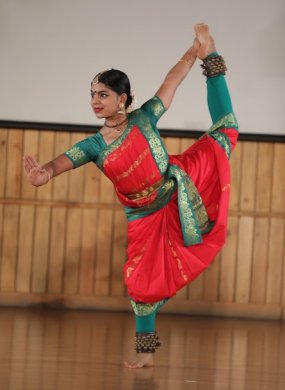 Bharatanatyam demo The last segment involved Ananda's experience with her own productions. Navarasa was composed minus story or lyrics, and the dancers demonstrated a couple of rasas. Ananda said electronic instruments must be judiciously used or else it becomes jarring. The music accompaniment included S.Venumadhav on vocal, TP Balasubramanian on mridangam and Saikumar on violin. It was a neatly capsuled presentation on music for Bharatanatyam for margam, Kalakshetra's group work and her own productions. 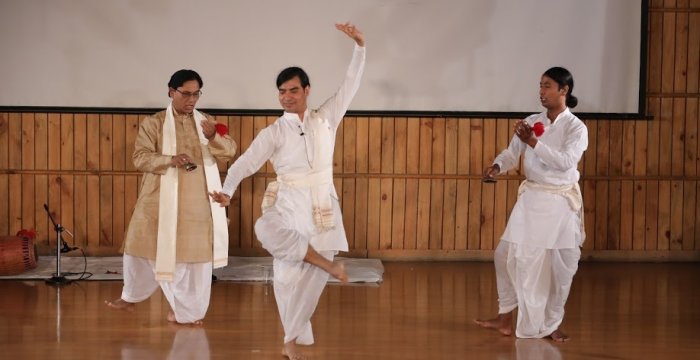 Muhikanta Bora Barbayan, Bhabananda Barbayan, Niranjan Saikia Bayan The next session was on 'Music for Sattriya' by Dr. Bhabananda Barbayan from the Uttar Kamalabari Sattra in Majuli Island, Assam. The chair, Dr.Sunil Kothari who has edited a book on Sattriya dances, gave a general introduction before the artistes took over. Bhabananda Barbayan is a seventh generation monk in his family. At 16, he became the youngest Barbayan of the Sattra. He has a double masters in Geography and Literature, is the first traditional practioner to do PhD in Sattriya dance and is currently doing his post doctorate in neuro-somatic integration program, the science of how neurons react when a person is performing. Bhabananda Barbayan gave a brief introduction to the dance form and elaborated on the different aspects of Sattriya dance. Srimanta Sankaradeva is the founder of the Sattriya tradition. Though Sattriya dance is more than 500 years old, it was unknown outside the Sattras (monastries). The music and the dances were used as vehicles of religious communication, and only the inmates of the Sattras had access to them. With Sattriya getting classical dance status, the dance and music is now seen outside the Sattras, in India and abroad. Being an integral part of dance and drama, the music has been practiced through ritual ceremonials in the Namghar or Kirttanghar of Sattras. There are two kinds of ceremonials in Sattriya music practice i.e. daily and occasional (mostly related to dance and drama). He said there are 14 rituals to be observed through the day. But at the daily rituals in the Sattra, the acrobatic percussion movements are not done, it is only for special occasions. "Like other forms of music, Sattriya may also be categorized into vocal and instrumental. In vocal, the two groups of songs composed by Srimanta Sankaradeva and his disciple Madhabadeva are known as Bargita and Anka-git or natar-git. Although it is not mentioned what tala were used in Bargit, they are presented in different talas according to the tradition of a particular Satra. In case of anka or natar-git it is found on record that only 8 talas were used. 74 variety of tala patterns have been collected from different sources of the Sattras during my research work," said Bhabananda followed by a brief demo. "In Nama prasanga (prayer), the songs are not accompanied by any instrument. When sung along with percussion instruments like khol and taal they are presented in two different ways. Mela- sanchara is sung everyday during evening prayer and the other one is called Bandha- sanchara which is sung during occasional ritualistic performances with dance, drama and specific musical sessions. Through the literary works of Sankaradeva and Madhabadeva we can find the names of different musical instruments which were being played at that time. Instruments that are still in use in the different Sattras are: khol, mridanga, nagara, ḍabaa etc (percussion), bartaal, bhortaal, patitaal, maṇjirataal, khutitaal, ghanta etc. (cymbals), flute, sarindar (string instrument)." In keeping with the focus of the seminar, Bhabananda emphasized only on the traditional way of music accompaniment in Sattriya dance. The music defines the character entering the stage, like a patra pravesa. The Sattriya dance can be categorized into two categories i.e. Purush Pradhan (male) and Prakiti Pradhan (female). Examples of male oriented dances include Jhumura Naach, Behaar or Bihaar Naach, Naadubhongi Naach, and Bor Probesor Naach which is composed on the concept of Krishna returning to Gokul from Brindavana with his Gopa friends, was demonstrated. Caali Naach is a female oriented dance with delicate movements performed in the Sattras on the day before Guru-kirtana commences. In Ojapali, the Oja or leader is placed in the centre and the Pali or the assistants encircle and accompany him. The Oja presents a story by acting, singing and dancing with the help of raga, sloka, upadesh etc. To learn both music and dance is a must for the Sattra inmates. One who sings is gayana and one who plays is bayana. The presentation which combines these two aspects is gayan-bayan. Sattriya dance has evolved into an independent art form but it has its origin as an integral part of the plays written and enacted by Srimanta Sankaradeva and Madhabadeva. Madhabadeva presented the dance items on attractive stage separated from the main drama and nurtured them as independent art forms. Graceful excerpts of Jhumura, Ojapali and Gayan Bayan were demonstrated with Muhikanta Bora Barbayan on vocal, while Bhabananda Barbayan and Niranjan Saikia Bayan took turns on the khol and dance. Going through the well thought out lec-dem at an unhurried pace, the voice modulation soft, yet audible, a peace permeated the presentation as the audience watched in rapt attention, enveloped in an almost meditative mood. 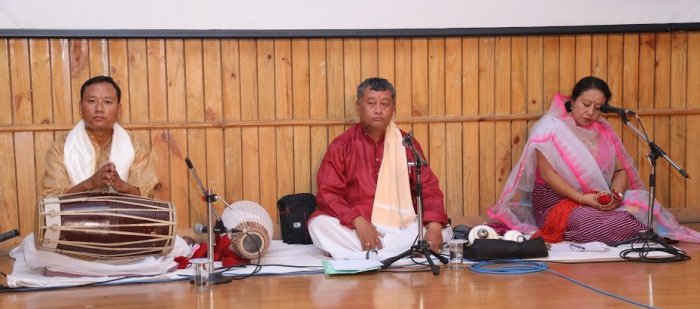 Nokuljeet Singh, Rameshkumar Singh, A. Gayatri Devi 'Music for Manipuri' was presented by L. Upendro Sharma of JNMDA, Imphal. He was accompanied by Kh. Rameshkumar Singh (violin and conch player), Th. Nokuljeet Singh (pung artist) and A. Gayatri Devi (vocalist). Sharma said, "Listening to the Manipuri singer singing takes you to a transcendental level. You can see an inflow of multiple streams of traditions in Manipuri music. How they flow into classical stream can be seen in the Rasaleela. Though the voice is high pitched in devotion, the expression is towards the soul, in bhakti rasa." Giving a brief history of Manipur, Sharma spoke of the pre-Vaishnavite era, Natasankirtan and Rasaleela traditions, and solo or creative dance. Manipuri tradition is more than 2000 years old, following more than 300 gods and goddesses. The musical accompaniment for Manipuri dance comes from the pung (percussion), a singer, kartals (cymbals), sembong, harmonium, pena (stringed instrument) and flute. There are many music and dance styles, prominent being Natasankirtan and Rasaleela. Natasankirtan is a male prerogative while the Rasaleela dance is performed by women. Lai Haraoba (meaning 'Festivity of the gods') is a native festival of the Meiteis, and is a combination of religious recitations, traditional music and dance. The instruments used include dholak and pena and Nokuljeet gave a demo of playing on the pena. Sharma said Natasankirtan became popular after Manipur converted to Vaishnavism and a Natasankirtan artiste should know 4 tyles of abhinaya. Sankirtana is found in Nupa Pala (male singing) and Nupi Pala (female singing). Maharaja Bhagyachandra (r. 1759-1798 CE) composed three of the five types of Rasaleela, the Maha Ras, the Basanta Ras and the Kunja Ras, performed at the Sri Sri Govindaji temple in Imphal during his reign and also the Achouba Bhangi Pareng dance. Upendro Sharma concluded by stating that Manipuri is a group oriented dance form and solo tradition is not very strong in Manipuri. Rameshkumar Singh blew on a double conch while Gayatri Devi impressed the rasikas with rendition of a song "dedicated to the god and goddess of the lake dedicated to the prosperity of the land" apart from other Manipuri items like Nupi Pala (community prayers involving dance and music performed during various social and religious occasions) and Khubak Ishei (clap dance performed by men and women during the Rathayatra). The final session of the Conclave was on 'Disseminating arts and culture winning strategies' chaired by Dr. Ananda Shankar Jayant with panelists C. Anjaneya Reddy, Dr. Sunil Kothari and Dr. Suresh Goel speaking on their respective experiences in their fields. It was specially organized for the officers training in the academy, so it was very different from the other sessions on music. With her experience as officer, Ananda could focus on the right points targeted at the officers. The excerpt from her production Navarasa and the EQ / IQ connection, was apt. The small interludes with 5 office situations were conceived and created by her senior dancers Sneha Magapu and Aditi Rao - all situations that one sees at the work place. Abstracting everyday situations into dance were interestingly done. On the whole, the morning presentations were very informative and well presented, but too many sessions do become an overload, so perhaps next year, these could be more suitably adjusted so there is breathing time for the rasikas! It was a well attended event and congratulations to Madhavi Puranam and team for putting this annual conclave already on the cultural map of Hyderabad. Lalitha Venkat is the content editor of www.narthaki.com |